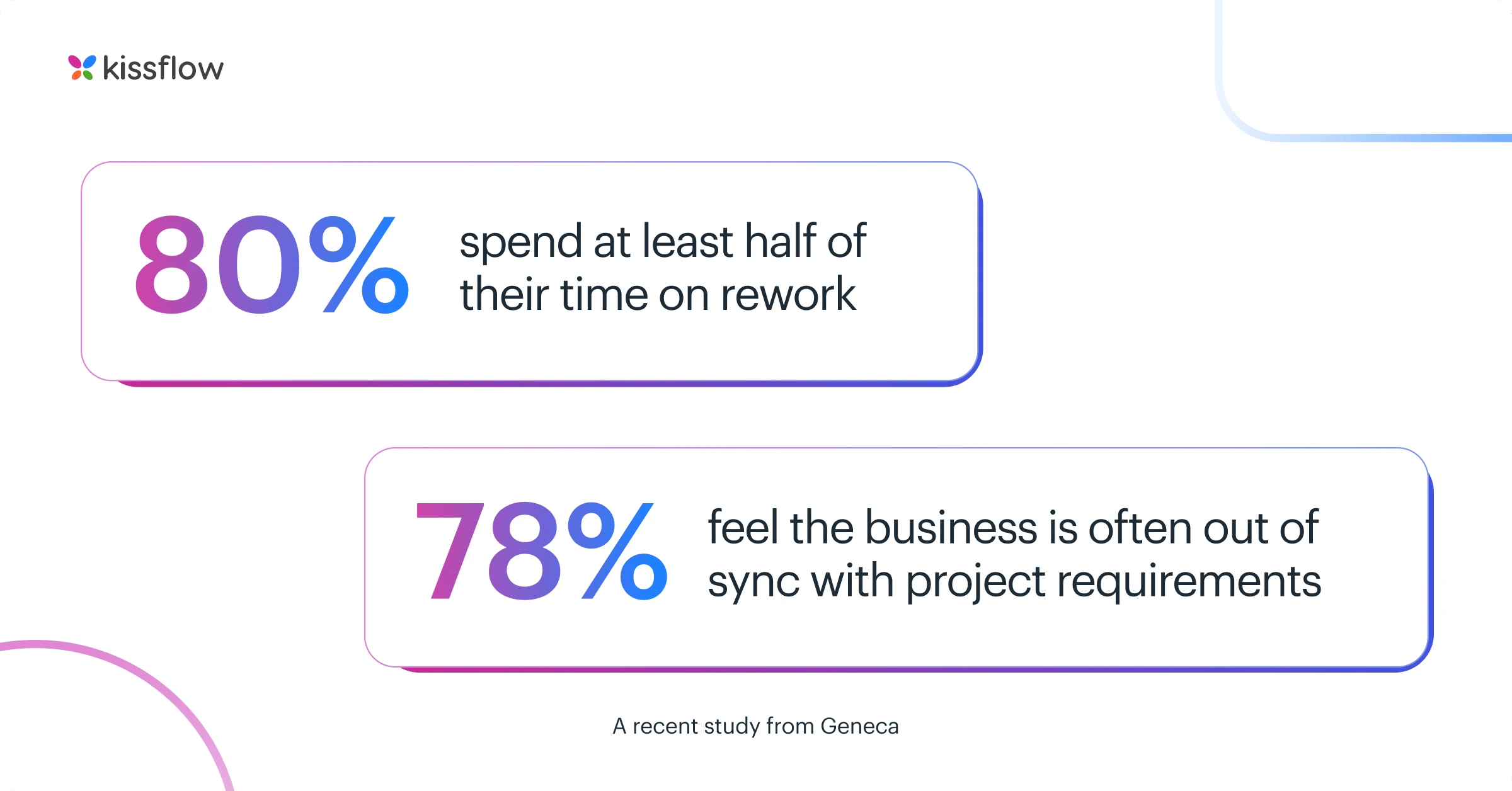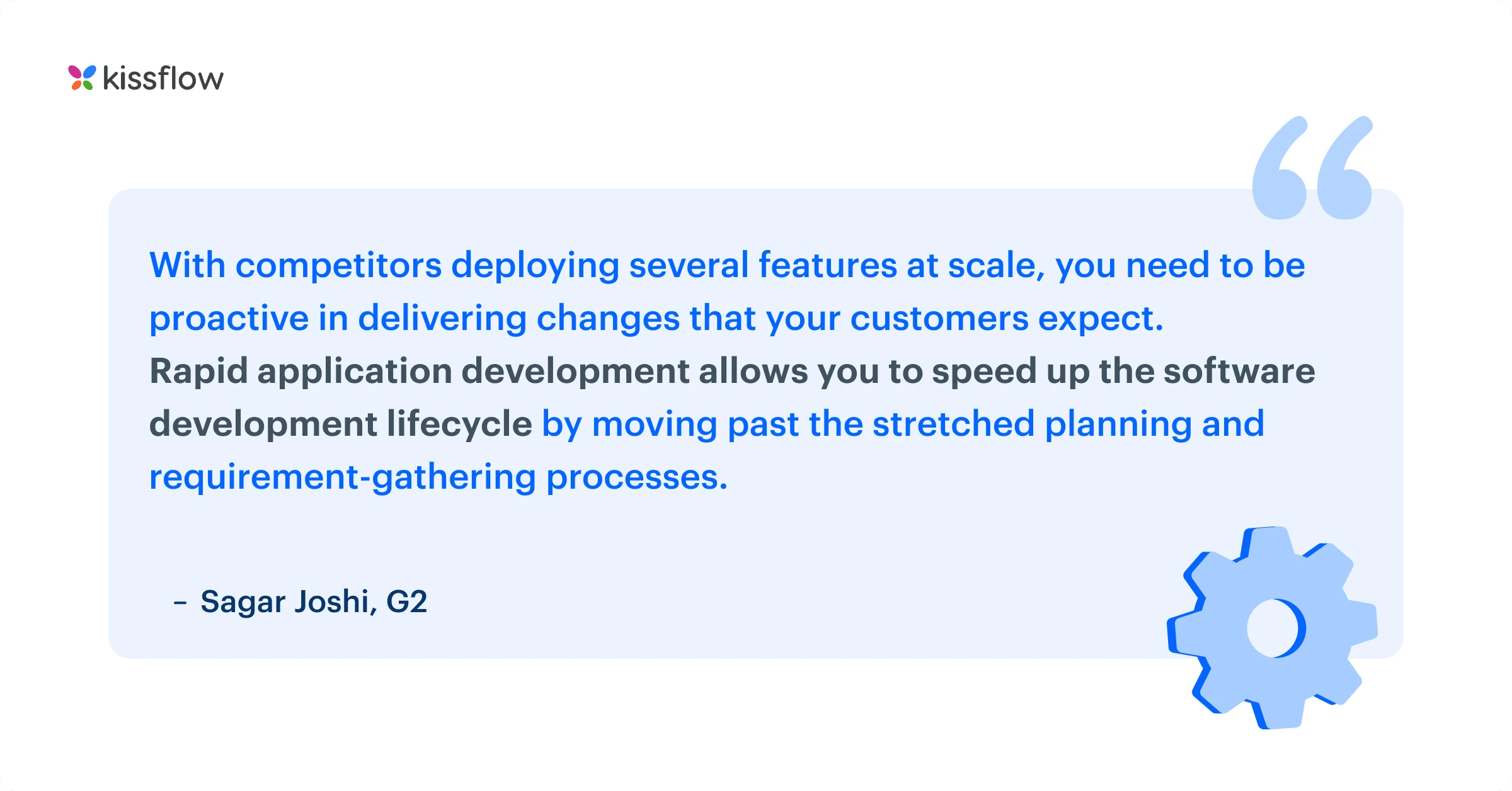
- >
- Application Development >
- 13 RAD Benefits, Including the Ones You Haven’t Thought Of
13 RAD Benefits, Including the Ones You Haven’t Thought Of
Team Kissflow
Updated on 28 Apr 2025 • 5 min read
Ever since it came on the scene as an alternative to the waterfall development method, rapid application development (RAD) has been a favorite of both developers and clients who value usable software that works.
RAD tools empower enterprises to accelerate their development cycles, improve collaboration, reduce costs, and deliver high-quality applications in a fraction of time.
For CIOs planning to achieve complete digital transformation, RAD can scale development by including business users in the process and giving them the tools that they need to build custom workflows supporting diverse business needs.
Why software is just different
A recent study from Geneca revealed these facts:

- 75%[1] of IT professionals admit that their projects are either always or usually “doomed from the start”
- 80% spend at least half of their time on rework
- 78% feel the business is often out of sync with project requirements and needs to be more involved
It’s obvious that when business units request software, traditional engineering models don’t always fit.
How is RAD unique?

The essentials of RAD are that it is based on a repository of reusable code, quickly-made prototypes, frequent client feedback, and a focus on usable software.
RAD takes into account that clients may not know exactly what they want until they see the software in action, thus doing detailed planning may be a waste of time.
“With competitors deploying several features at scale, you need to be proactive in delivering changes that your customers expect. Rapid application development allows you to speed up the software development lifecycle by moving past the stretched planning and requirement-gathering processes.
The RAD model enhances customer satisfaction by facilitating high-level collaboration of all stakeholders.” says Sagar Joshi, G2.

How to Choose an App Development Platform for Your Enterprise [ Checklist Included ]
Thank you for reaching us!
Thank you for reaching us!
Before the RAD benefits, a caveat
Getting all of the amazing benefits of RAD is heavily dependent on the following factors. If your project is lacking even one of these, the advantages could easily turn into liabilities.
Good client involvement
RAD depends heavily on a lot of client interaction. If your client is hard to meet with, has poor communication skills, or doesn’t seem to be that interested in the development process, RAD may not be the best strategy.
Good project management skills
Due to its slightly nebulous nature, RAD requires a project manager who is extremely adaptable and flexible but also focused on results. Without a clear-minded project manager, RAD can spiral into constant changes and never result in market-ready software.
Highly skilled developers
RAD works when you have developers who are multi-talented and can quickly adapt to new situations. RAD isn’t best for someone at the start of their career who must spend a long time learning the basics of each requirement.
Moderate product size
When the scope of the project grows extremely large, RAD’s benefits often fade away because you have too many moving and changing parts and too many teams working on multiple elements. Extremely small projects may also be better suited to a more straightforward development process.
The big list of RAD benefits
The advantage of Rapid Application Development (RAD) is that it streamlines your business operations and allows them to be more collaborative and effective. Many businesses prefer the RAD approach because of its reusable code, swiftly-made prototypes, regular client feedback, and enhanced flexibility. The following are the advantages of RAD,
1. Quicker delivery
We’ll start with the easy one since it’s built into the name. RAD promises faster end delivery of the software because it is highly iterative and can get to the goal quicker.
2. Quicker adjustments
Things often change as the development process goes on. RAD gives a framework where these midstream adjustments are actually encouraged and made quickly during development.
3. Fewer errors
Because RAD utilizes a repository of components for reuse, there are often fewer errors in the code which usually makes the testing time shorter as well. The final product will already be tested and have fewer defects than other methods.
4. Lower development cost
RAD may require more money spent on talented developers. However, by shortening the development time, these costs may work out to be the same. The big cost advantage of RAD is that you never have to rerun the project again from the beginning if the client wants major changes, leading to less cost overrun.
5. Lower maintenance costs
Once an application is released using RAD, maintenance is generally quick and painless. With traditional models, any fixes require significant planning, testing, and staffing.
6. Faster release of versions
For applications developed through RAD, releasing a new version of the product feels just like another iteration and can be done quickly, as opposed to creating a large plan that can take many months to complete.
7. Better adoption of new technologies
If you are involved in a waterfall project and new technology emerges that might help you, there’s very little chance you can add it; there’s just too much risk and work to go back and change the requirements. With RAD, new technologies can be immediately tried, tested, and evaluated.
8. More involvement from business
RAD relies on lots of involvement with the client and end user. Development happens frequent updates, which means the end product will be closer in scope to what the client actually wants.
9. More usable software
When planning under a traditional model, developers will focus on the areas that are most interesting or challenging to them. With RAD, the question is always what the client actually needs. Therefore, in the end, the final product will be much more usable instead of just being a technological marvel.
10. Better risk control
With RAD, you can focus on risk factors early in the process and continue to discuss them as development goes on. Risks may also reveal themselves during development and can be addressed immediately. In other models, risks are put on hold until the final version appears, which sets you up for many risks you did not consider at the beginning.
11. Happier clients
In general, IT teams that use RAD principles will have a better relationship with business clients as they are more collaborative and deliver more useful products to them, as opposed to living in an ivory tower and giving the business whatever IT wants to give.
12. Less chance of catastrophe
Everyone has seen or heard of that project that lasted for months and in the end had to be trashed at a great loss of time, money, and morale. RAD principles can help you avoid such terrible situations as any doomed project will be weeded out much earlier.
13. Better integrations
In the waterfall method, integrations with other software are one of the last things to happen. With RAD, they are built throughout the process. Integrations can make or break the effectiveness of an application, and knowing how they will function early on is key.
RAD is a great model for development because it fits in with how business users look at software. It isn’t the perfect model for every project, and certain best practices need to be followed. But, if you do it right, you can enjoy lots of benefits of RAD throughout the lifecycle of your applications!
Get all the benefits of RAD with low-code!
There are numerous benefits of using low-code platforms like Kissflow for online application development. Kissflow enables faster time to market by involving both IT and business users in the development process. Its visual drag-and-drop form builder allows users to quickly build custom applications with little to no coding. You can make changes in real-time, add new features, or modify existing applications without any extra efforts.
The powerful analytics and reporting capabilities also allow you to analyze existing workflows to identify bottlenecks and areas of improvement. With Kissflow, you can create modern and sophisticated applications and turbocharge rapid application development platform. Discover how Kissflow Low-Code App Development platform can streamline your development process.
Start building your dream app today!
-3.webp)
How much could your organization save with low-code?
Get the impact of a low-code/no-code platform on your application development costs
Related Articles











